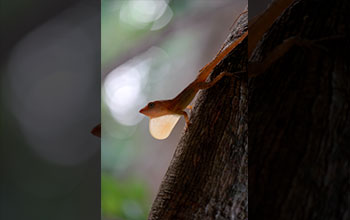Multimedia Gallery
Male Jamaican gray lizard (Anolis lineatopus)
A male Jamaican gray lizard (Anolis lineatopus) displays its colorful throat fan, called a dewlap. Light passes through the dewlap from the back, giving a glowing appearance that helps attract a mate.
More about this image
Male anole lizards attract a mate by perching on a tree limb, bobbing their heads up and down and extending their colorful dewlap.
Anoles that live in shaded habitats often have a translucent dewlap, which pass as much -- or more -- light through it from the back as it reflects from the front, creating a glowing effect.
A recent study of Jamaican gray lizards by the University of Missouri found this glowing effect increases the efficacy of the male lizard's visual signal, making them stand out better to females. This is particularly important for lizards living in a visually "noisy" habitat, such as a shady forest, where branches and trees waving in the breeze make it difficult to stand out.
Manuel Leal, a biologist at UM and co-author of the study, and his colleagues found the perceptual overlap between the colors of the lizard's throat fan and the natural colors of the background decreased when light is transmitted through the dewlap.
"Allowing light to pass through the dewlap makes the colors of the dewlap much easier to detect and to distinguish against other objects in the background, which means the signal is easier to see by potential mates and rivals," explained Leal. "In other words, it increased the signal-to-noise ratio."
This research was supported by the National Science Foundation (grants IOS 1051793 and IOS 1051796).
To learn more, see the video Why do Anolis lizard dewlaps glow? Or see the UM news story Look at me! Forest-dwelling anoles 'glow' to attract attention. (Date image taken: July 2011; date originally posted to NSF Multimedia Gallery: Jan. 28, 2016)
Credit: Manuel Leal, Division of Biological Sciences, University of Missouri, Columbia
Images and other media in the National Science Foundation Multimedia Gallery are available for use in print and electronic material by NSF employees, members of the media, university staff, teachers and the general public. All media in the gallery are intended for personal, educational and nonprofit/non-commercial use only.
Images credited to the National Science Foundation, a federal agency, are in the public domain. The images were created by employees of the United States Government as part of their official duties or prepared by contractors as "works for hire" for NSF. You may freely use NSF-credited images and, at your discretion, credit NSF with a "Courtesy: National Science Foundation" notation.
Additional information about general usage can be found in Conditions.
Also Available:
Download the high-resolution JPG version of the image. (2.9 MB)
Use your mouse to right-click (Mac users may need to Ctrl-click) the link above and choose the option that will save the file or target to your computer.



